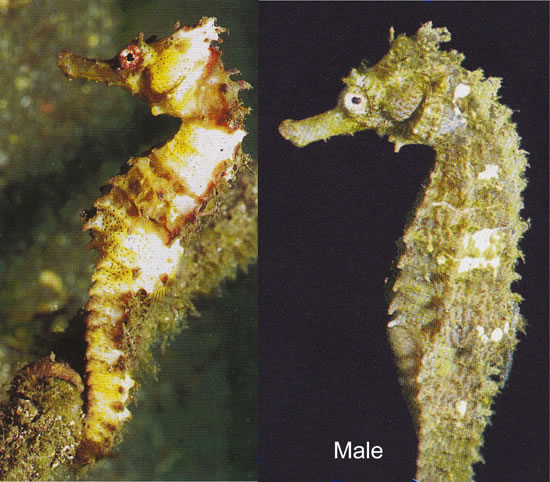- Classification
- ACTINOPTERYGII
- SYNGNATHIFORMES
- SYNGNATHIDAE
- Hippocampus
- semispinosus
Halfspine Seahorse, Hippocampus semispinosus Kuiter 2001

A Halfspine Seahorse, Hippocampus semispinosus. Source: Rudie Kuiter / Aquatic Photographics. License: All rights reserved
The Halfspine Seahorse is a slender-bodied species with only a specimen possibly collected off North Western Australia.
Halfspine Seahorse, Hippocampus semispinosus Kuiter 2001
More Info
|
Depth |
trawled |
|
Photo Rights |
T Tonozuka |
|
Distribution |
Tropical West Pacific, known from the East Alas Strait, Indonesia and the Timor Sea and possibly from the Northwest Shelf, WA; trawled on muddy substrate habitats near mangroves to deeper muddy channels. |
|
Features |
Meristics: D 18; P 16-17; trunk rings 11; tail rings 35-36; subdorsal rings 2 + 1. |
|
Size |
Height to 137 mm. |
|
Colour |
In life, female coloration variable, from dark red to yellow with grey saddle-like blotches over 1st and 2nd, and 6th to 8th trunk rings, and over 3rd to 5th tail rings; tip of snout pale. Some males dark brown with several large creamy-white blotches laterally on trunk. In preservative - pale to brownish with pale blotches on trunk, snout, pouch creamy-white. |
|
Feeding |
Carnivores. Like most other seahorses, this species presumably feeds by sucking small prey items such as crustaceans and planktonic zooplankton into its mouth. |
|
Biology |
Reproduction: Sexes separate, reproduction a form of viviparity or ovoviviparity, whereby the males give birth to tiny independent young. The female uses an ovipositor to transfer her eggs into an elaborate enclosed pouch under the abdomen of the male. The male not only fertilizes the eggs inside the pouch and provides physical protection for the developing embryos, he also osmoregulates and aerates the embryos and may provide some nourishment until the offfspring are born. |
|
Fisheries |
None. Although collected in trawls, there is no known trade in this species for the aquarium or Asian Traditional Medicine industries. |
|
Conservation |
International: Listed under Appendix II of the Convention on the International Trade in Endangered Species of Wild Flora and Fauna (CITES). As a result, the species is subject to the Convention, http://www.cites.org/. |
|
Remarks |
Often has algal growth on spiny ridges. |
|
Similar Species |
H. semispinosus is most similar to H. moluccensis, which does not occur in Australian waters and differs in having fewer dorsal-fin rays and a shorter snout. H. semispinosus has a longer and more slender snout than H. alatus and H. queenslandicus and differs considerably in coloration. |
|
Etymology |
From the Greek ippos = horse and kampe = curvature. The specific name semispinosus is from the Latin semi- meaning half and spinosus meaning thorny, in reference to the appearance of this species being intermediate between smooth and long-spined species. |
|
Species Citation |
Hippocampus semispinosus Kuiter 2001, Rec. Aust. Mus. 53: 320, fig. 29, East Alas Strait, Indonesia. |
Halfspine Seahorse, Hippocampus semispinosus Kuiter 2001
References
Hoese, D.F., D.J. Bray, J.R. Paxton & G.R. Allen. 2006. Fishes. In Beesley, P.L. & A. Wells. (eds.) Zoological catalogue of Australia. Volume 35. ABRS & CSIRO Publishing: Australia, 2178 pp.
Kuiter, R.H. 2000. Seahorses, Pipefishes and their Relatives. TMC Publishing, Chorleywood, UK, 240 pp.
Kuiter, R.H. 2001. Revision of the Australian Seahorse of the genus Hippocampus (Syngnathiformes: Syngnathidae) with descriptions of nine new species. Rec. Aust. Mus. 53: 293-340.
Pogonoski, J.J., D.A. Pollard & J.R. Paxton. 2002. Conservation Overview and Action Plan for Australian Threatened and Potentially Threatened Marine and Estuarine Fishes. Canberra, Environment Australia, 375 pp.

